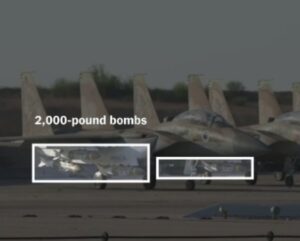2,000-Pound Bombs Used in Attack That Killed Nasrallah, Analysis Reveals
2,000-Pound Bombs Used in Attack That Killed Nasrallah, Analysis Reveals

A recent analysis by The New York Times has determined that the Israeli military utilized at least eight aircraft armed with bunker-buster bombs in the attack that resulted in the death of Hezbollah leader Hassan Nasrallah.
The video released by the Israeli military features multiple jets reportedly involved in the operation, each equipped with 2,000-pound bombs, as confirmed by munitions experts. Among the weapons identified was the American-made BLU-109, which is designed for precision strikes thanks to its JDAM guidance system. Trevor Ball, a former U.S. Army explosive ordnance disposal technician, noted that these bombs are capable of penetrating underground structures before detonation.
Wes Bryant, a former U.S. Air Force targeting expert, corroborated this assessment, stating that the bombs seen in the video align with what would be expected for an attack on Nasrallah’s underground facilities.
In May, the Biden administration had previously paused the shipment of similar 2,000-pound bombs to Israel, citing concerns for civilian safety in Gaza.
The Israeli military’s video, shared on its official Telegram channel, indicated the involvement of fighter jets in the attack, showing at least eight aircraft equipped with these heavy munitions. While some jets were too distant to identify the exact type of bomb, closer images clearly showed BLU-109 models. The video captured one aircraft returning to its base at dusk without any munitions after taking off with a significant payload.
Although the video did not depict the bombs being dropped, Ball noted that subsequent footage of explosions in densely populated areas of southern Beirut aligns with the damage expected from 2,000-pound bombs.
Additional analysis of verified footage, photos, and satellite images revealed that the strike demolished at least four high-rise apartment buildings in the area.
Israeli defense officials disclosed that over 80 bombs were deployed during the operation targeting Nasrallah, but they did not confirm the specific types of munitions used. The Israeli military declined to comment on the video or the attack itself. U.S. officials directed inquiries regarding the munitions back to the Israeli military.
Following the strikes, Lebanon’s health ministry reported that at least 33 individuals had died, with over 195 injured, a toll that may increase as rescue efforts continue.
This assassination marks a significant escalation in Israel’s ongoing conflict with Hezbollah, which has intensified since the group began firing into northern Israel in solidarity with Hamas. With tensions rising, there are growing concerns about a broader regional conflict potentially involving major powers like Iran.
TRENDING SONGS
 Ahmad Yerima: Naval Officer to Face No Sanctions After Clash with Wike – Matawalle
Ahmad Yerima: Naval Officer to Face No Sanctions After Clash with Wike – Matawalle
 Trending Video: Muslim Man Joins Wife in Hallelujah Challenge ‘Dress Like Your Miracle’ Night
Trending Video: Muslim Man Joins Wife in Hallelujah Challenge ‘Dress Like Your Miracle’ Night
 Woman Seeks Advice as Late Brother’s Wife Refuses to Mourn Him Following His Death With Alleged Mistress
Woman Seeks Advice as Late Brother’s Wife Refuses to Mourn Him Following His Death With Alleged Mistress
 Nobody Cares About Fine Girls In The UK, I Miss Nigeria — Nigerian Lady Laments
Nobody Cares About Fine Girls In The UK, I Miss Nigeria — Nigerian Lady Laments
 Wedding Called Off: How Lady Cancels Wedding After Finding Out Finance’s Affairs With Her Bestie
Wedding Called Off: How Lady Cancels Wedding After Finding Out Finance’s Affairs With Her Bestie
 Heartbreak in Ikeja: Lady Weeps After Fufu Found in New Phone Package
Heartbreak in Ikeja: Lady Weeps After Fufu Found in New Phone Package
 Twist of Fate: Man Who Questioned Phyna’s ₦1Billion Demand Mourns Brother in Dangote Truck Crash
Twist of Fate: Man Who Questioned Phyna’s ₦1Billion Demand Mourns Brother in Dangote Truck Crash
 Tragedy in Enugu: Dangote Truck Claims Lives of Family of Five
Tragedy in Enugu: Dangote Truck Claims Lives of Family of Five
 Bangkok Crackdown: Nigerian-Thai Couple in Police Net Over Drug Trafficking
Bangkok Crackdown: Nigerian-Thai Couple in Police Net Over Drug Trafficking
 Family Rift: Reno Omokri’s Ex-Wife Says He Deserted Their Special Needs Son
Family Rift: Reno Omokri’s Ex-Wife Says He Deserted Their Special Needs Son
Share this post with your friends on ![]()













